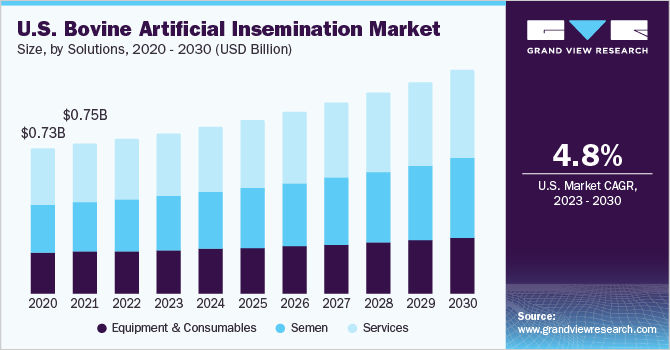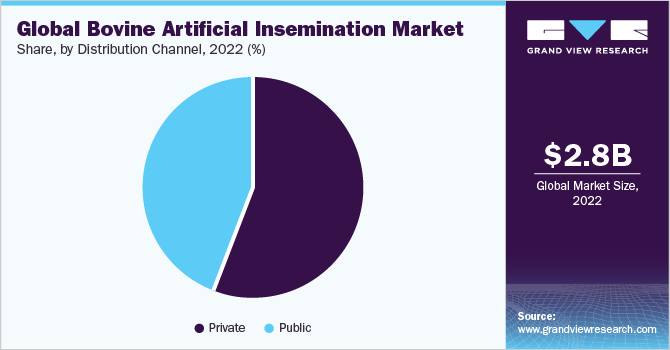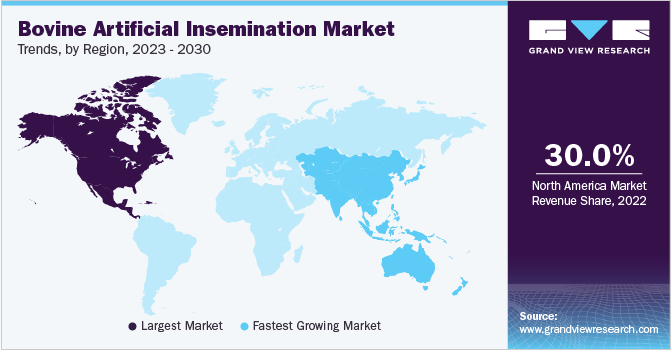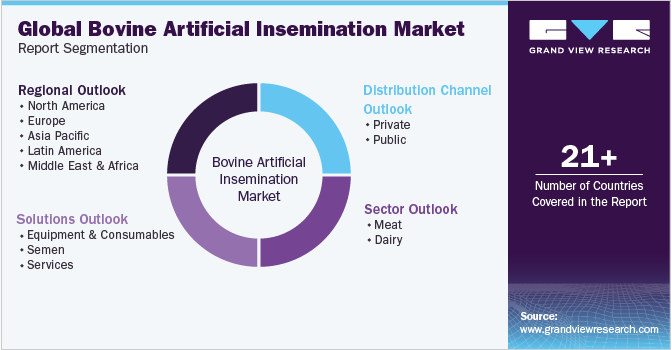
Bovine Artificial Insemination Market Size, Share & Trends Analysis Report By Solutions (Equipment & Consumables, Semen, Services), By Sector (Meat, Dairy), By Distribution Channel (Private, Public), By Region, And Segment Forecasts, 2023 - 2030
- Report ID: GVR-4-68040-066-5
- Number of Pages: 150
- Format: Electronic (PDF)
- Historical Range: 2018 - 2021
- Industry:Healthcare
Report Overview
The globalbovine artificial insemination market sizewas valued atUSD 2.84 billion in 2022and is estimated to grow at a compound annual growth rate (CAGR) of 6.17% from 2023 to 2030. Increasing demand forbeefand dairy products, the need for sustainable food production, advancements in bovine reproduction technology, and supportive initiatives by market participants are some of the key factors driving the market growth.

In 2022, Genus plc, a key market player, reported a revenue of 272 million pounds (USD 340.64 million) from ABS Global, its bovine genetics division. The company also reported a 3% increase in bovine (semen and embryo) volumes to 25.1 million units, with an 18% surge in sexed semen volumes of its Sexcel and IntelliGen product lines. Strong growth was reported from the Asia and North America regions.
The COVID-19 pandemic of 2020-21 and macroeconomic headwinds of 2022-23 had a notable impact on the market, with supply chain challenges, dampened growth rate, reduced sales & marketing activities, etc. However, the market is expected to grow notably through 2030, as the underlying drivers continue to fuel its progress. In its 2023 outlook, Genus plc reported no change in its medium-term growth expectations despite the macroeconomic conditions. The company aims to continue leveraging opportunities in the market by promoting the adoption of sexed semen and beef/dairy genetics.
Supportive government initiatives are a key market driver. In India, the Ministry of Fisheries, Animal Husbandry and Dairying, for instance, initiated phase IV of its Nationwide Artificial Insemination Programme (NAIP) in August 2022. This covered about 33 million bovines through artificial insemination across 604 districts with less than 50% AI coverage. The Ministry also reported the production of 27.86 lakh doses of sex-sorted semenunder the Rashtriya Gokul Mission in 2022. Furthermore, in 2022, an online portal was launched for the distribution of High Genetic Merit (HGM) Bull.
Increasing awareness about the benefits of artificial insemination is another key driver fueling market growth. Artificial insemination, for example, facilitates farmers to breed more cows with a single bull's semen, thus reducing the need for keeping multiple bulls on the farm. This helps save time and resources while increasing breeding efficiency.
Artificial insemination also enables farmers to keep accurate records of the genetics and performance of their herds. This information can be used to make more informed breeding decisions and improve the productivity of the herd over time.In addition, it can help reduce the environmental impact of the bovine sector by improving the efficiency of breeding programs and reducing the need for large herds.
Solutions Insights
By solutions, the services segment dominated the market with a share of around 39% in 2022. The semen segment, on the other hand, is anticipated to advance at the highest CAGR of 6.88% during the forecast period. This is due to the growing awareness and adoption of bovine artificial insemination solutions across key markets. For example, Urus Group, one of the leading players in the market, has sold over 31.5 million straws of semen across the globe.
精液段内,正常的精液for the larger share of the market in 2022, while the sexed semen segment is projected to grow at the fastest rate of 8.77%. The use of sexed semen allows farmers to improve the genetics in their herds as well as increase their chances of a heifer calf. In fact, as per VikingGenetics, over 70% of the VikingJersey semen sold by the company in 2020 was sexed semen. Thus, growing initiatives by market stakeholders and awareness about the benefits of sexed semen are estimated to fuel segment growth in the coming years.
Sector Insights
The dairy sector dominated the bovine artificial insemination market in 2022 with around 62.0% revenue share. It is also projected to expand at the fastest CAGR of 6.60% from 2023 to 2030. Increasing production of milk, rising consumption of dairy and dairy products, and the need to obtain animal protein sustainably are some of the key factors accounting for the share of the segment.
For instance, according to the 2022 OECD-FAO Agricultural Outlook, milk production across the world is estimated to increase from 901,646 kt pw in 2022 to 1,059,850 kt pw in 2031. Additionally, global consumption of fresh dairy products is projected to increase from 453,492 kt pw in 2022 to 555,998 kt pw in 2031.
The meat sector also held a significant share of the market in 2022, owing to increasing initiatives to ensure the safety of food sources and initiatives by market players.NuEra Genetics from ABS Global is an exclusive beef genetic program comprising SimAngus hybrid composite sires specifically selected for traits important to the beef supply chain- feed efficiency, growth, and carcass merit. It was developed to improve profitability through focused terminal genetic selection.
Distribution Channel Insights
In terms of distribution channel, the private segment held the highest share of 55.65% of the market in 2022. The segment is also estimated to witness the fastest growth of 6.73% during the projection period. Most companies operating in the market engage in direct sales activities or indirect sales via distribution partnerships. For instance, Genex (Urus Group) provides online shopping for bovine genetics and several herd care products. Customers can browse through product options from the company’s online catalog.

STgenetics too offers online catalogs, such as its Colored Breeds Specialist Catalog and Beef Add On Specialist Catalog for April 2023, to provide a comfortable shopping experience for its customers. Similar online shopping options are offered by other key players such as ABS. For instance, dairy semen options offered by ABS include Brown Swiss, Holstein, Jersey, Norwegian Red, St. Jacob’s, and Ayrshire. The public channel segment is also expected to hold a notable share of the market over the forecast period owing to various supportive initiatives deployed by governments.
Regional Insights
By region, North America held the largest share of over 30% of the global market for bovine artificial insemination in 2022. This share is attributed to the high adoption of artificial insemination solutions across the region as well as the increasing need to meet animal protein demand more sustainably. With artificial insemination, farmers have better control over the genetic traits of their bovines. They can choose sires with specific traits such as high milk production, disease resistance, or meat yield, and use them to breed cows that will produce offspring with similar characteristics.

Asia Pacific is estimated to expand at the highest CAGR of more than 7% from 2023 to 2030. This is due to rising awareness about the benefits of artificial insemination in bovines, the presence of local players, and supportive government initiatives. As per the National Dairy Development Board, India, bovine artificial insemination coverage in the country is about 30%, which amounts to around 80 million inseminations per year. Efforts to increase coverage include the breeding infrastructure formed under NDP I and RGM Scheme of the Indian government. This is expected to fuel regional growth.
Key Companies & Market Share Insights
The market is fragmented owing to numerous companies offering artificial insemination equipment, consumables, semen, and services to bovine farmers. These companies implement several strategic initiatives to grow their market presence and share. Some of these initiatives include mergers & acquisitions, partnerships & collaborations, regional expansions, R&D, service launches, and more.
In June 2021, for example, ABS, the bovine division of Genus plc, partnered with World Wide Sires Deutschland GmbH to jointly operate as World Wide Sires Deutschland in Germany, Austria, and Luxembourg as a distribution partner of ABS. Urus Group, another key player in the market, offers a wide bovine genetics portfolio via its independent subsidiaries, namely GENEX, Alta Genetics, PEAK, Trans Ova Genetics, etc. Some prominent players in the global bovine artificial insemination market include:
Genus plc
IMV Technologies
SEMEX
Jorgensen Laboratories
URUS Group
STgenetics
National Dairy Development Board
Munster Bovine
World Wide Sires, Ltd.
Cogent Breeding Ltd.
Bovine Artificial Insemination Market Report Scope
Report Attribute |
Details |
Market size value in 2023 |
USD 2.98 billion |
Revenue forecast in 2030 |
USD 4.54 billion |
Growth rate |
CAGR of 6.17% from 2023 to 2030 |
Base year for estimation |
2022 |
Actual estimates/Historical data |
2018 - 2021 |
Forecast period |
2023 - 2030 |
Quantitative units |
Revenue in USD billion & CAGR from 2023 to 2030 |
Report coverage |
Revenue forecast, company ranking, competitive landscape, growth factors, and trends |
Segments covered |
Solutions, sector, distribution channel, region |
Regions covered |
北美;欧洲;亚太地区;拉丁美洲; MEA |
Country Scope |
U.S.; Canada; UK; Germany; Italy; France; Spain; Netherlands; Poland; Japan; China; India; South Korea; Australia; New Zealand; Brazil; Mexico; Argentina; South Africa; Egypt; Iran |
Key companies profiled |
Genus plc; IMV Technologies; SEMEX; Jorgensen Laboratories; URUS Group; STgenetics; National Dairy Development Board; Munster Bovine; World Wide Sires, Ltd.; Cogent Breeding Ltd. |
Customization scope |
Free report customization (equivalent up to 8 analysts’ working days) with purchase. Addition or alteration to country, regional & segment scope. |
Pricing and purchase options |
Avail customized purchase options to meet your exact research needs.Explore purchase options |
Global Bovine Artificial Insemination Market Report Segmentation
This report forecasts revenue growth at the global, regional & country levels and provides an analysis of the latest industry trends and opportunities in each of the sub-segments from 2018 to 2030. For the purpose of this study, Grand View Research has segmented the global bovine artificial insemination market report based on solution, sector, distribution channel, and region:

Solutions Outlook (Revenue, USD Billion, 2018 - 2030)
Equipment & Consumables
Semen
Normal
Sexed
Services
Sector Outlook (Revenue, USD Billion, 2018 - 2030)
Meat
Dairy
Distribution Channel Outlook (Revenue, USD Billion, 2018 - 2030)
Private
Public
Regional Outlook (Revenue, USD Billion, 2018 - 2030)
North America
U.S.
Canada
Europe
UK
Germany
France
Italy
Spain
Netherlands
Poland
Rest of Europe
Asia Pacific
Japan
China
India
South Korea
Australia
New Zealand
Rest of Asia Pacific
拉丁美洲
Brazil
Mexico
Argentina
Rest of Latin America
Middle East & Africa
South Africa
Egypt
Iran
Rest of MEA
Frequently Asked Questions About This Report
b.The global bovine artificial insemination market size was estimated at USD 2.84 billion in 2022 and is expected to reach USD 2.98 billion in 2023.
b.The global bovine artificial insemination market is expected to grow at a compound annual growth rate of 6.17% from 2023 to 2030 to reach USD 4.54 billion by 2030.
b.By region, the North American bovine artificial insemination market held the largest share of about 30% of the global market in 2022. This share is attributed to the high adoption of artificial insemination solutions across the region as well as increasing need to meet animal protein demand more sustainably.
b.Some key players operating in the bovine artificial insemination market include Genus Plc; IMV Technologies; SEMEX; Jorgensen Laboratories; URUS Group; STgenetics; National Dairy Development Board; Munster Bovine; World Wide Sires, Ltd.; and Cogent.
b.Increasing demand for beef and dairy products, the need for sustainable food production, advancements in bovine reproduction technology, and supportive initiatives by market participants are some of the key factors driving the market growth.





